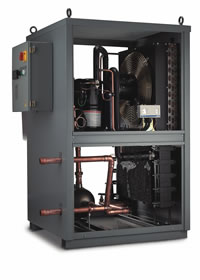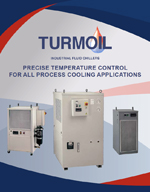
Turmoil application engineers are specialists, available to help you select or design a cooling system to meet your specific needs. They are very familiar with your applications and our equipment. Turmoil prides itself on being able to provide accurate technical data when you need it. So, if you need help, give Turmoil a call.
DETERMINING THE HEAT LOAD
The heat load is the amount of heat to be removed from the coolant as it passes through the chiller. In order to size a cooler, this heat load must be accurately determined. This can be done in several ways:
- Measure flow and temperature change.
The most accurate way to determine heat load is to measure the flow of the coolant. (This can be done by timing how long it takes to fill a five-gallon bucket.) Measure the change in temperature (Δ T) of the coolant as it enters and leaves the heat source. Calculate the heat load as follows:
Flow Rate (gal/hr) x Coolant Weight (lbs/gal) x Specific Heat of Coolant x ΔT°F = BTU/HR
- Measure the change in temperature of the coolant in the sump.
If there is a sump on your machine tool, measure the temperature of the coolant in the sump before machine startup. Then measure the temperature of that same coolant at 30-minute intervals for three hours after start-up while the machine is operating at full capacity. Determine the total volume of coolant in the sump and coolant loop. Take the hour interval with the greatest temperature change and plug the numbers into the following formula:
Gallons of Coolant x Coolant Weight (lbs/gal) x Specific Heat of Coolant x ΔT°F = BTU/HR - Size the cooler by the motor horsepower.
The coolant is heated either directly or indirectly by a motor or motors. Theoretically, if you know the motor horsepower you can easily determine the heat load. But, it is not always so simple. Duty cycle, motor efficiency, and ambient heat loss or gain can have a great effect on the heat load. However, if the motor horsepower is known and its operation is fairly steady at maximum output:
1HP = 746 WATTS = 2545 BT/HR
DETERMINING APPLICATION & COOLANT
It is very important to determine the type of cooler that is required. All applications involve a fluid passing through an evaporator (heat exchanger), but how does the coolant get there?
Closed-Loop coolers recirculate coolant from a tank mounted in the cooler, through the heat load and back to the tank. The tank, pump, and evaporator are all in the cooler.
Open-Loop coolers recirculate coolant from a remote tank, through the cooler and back to the tank. The pump and evaporator are in the cabinet. The tank is remote.
In-Line coolers cool fluid that is passing through the cooler under pressure. Only the evaporator is in the cooler. The pump and tank are remote.
Drop-In coolers are mounted on top of the coolant tank with the stainless steel evaporator coils submerged in the coolant.
Because water and oil have such different heat transfer characteristics, it is very important that the type of coolant being used is determined. If in doubt, specify an OCO cooler.
Water-Based Coolants are fluids that contain not more than 5% oil. These coolants may contain additives such as rust inhibitors, algaecides, and/or up to 30% glycol.
Oil-Based Coolants are fluids that contain more than 5% oil. Soluble oils, semi-synthetic fluids, hydraulic oils, cutting oils, and spindle oils are typical.
Clean Coolants are fluids that do not contain particles that could clog the pump or evaporator. The coolant is usually sealed from contamination or filtered to remove damaging particles.
Dirty Coolants contain or potentially can contain particles such as fines or chips that could clog the pump or evaporator. An In-Line filter or cleanable evaporator is often required.

